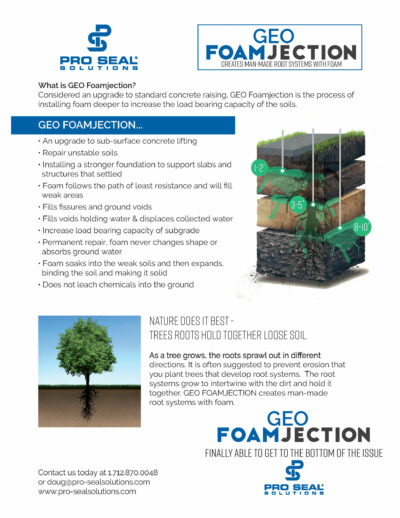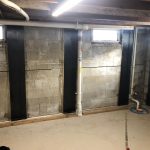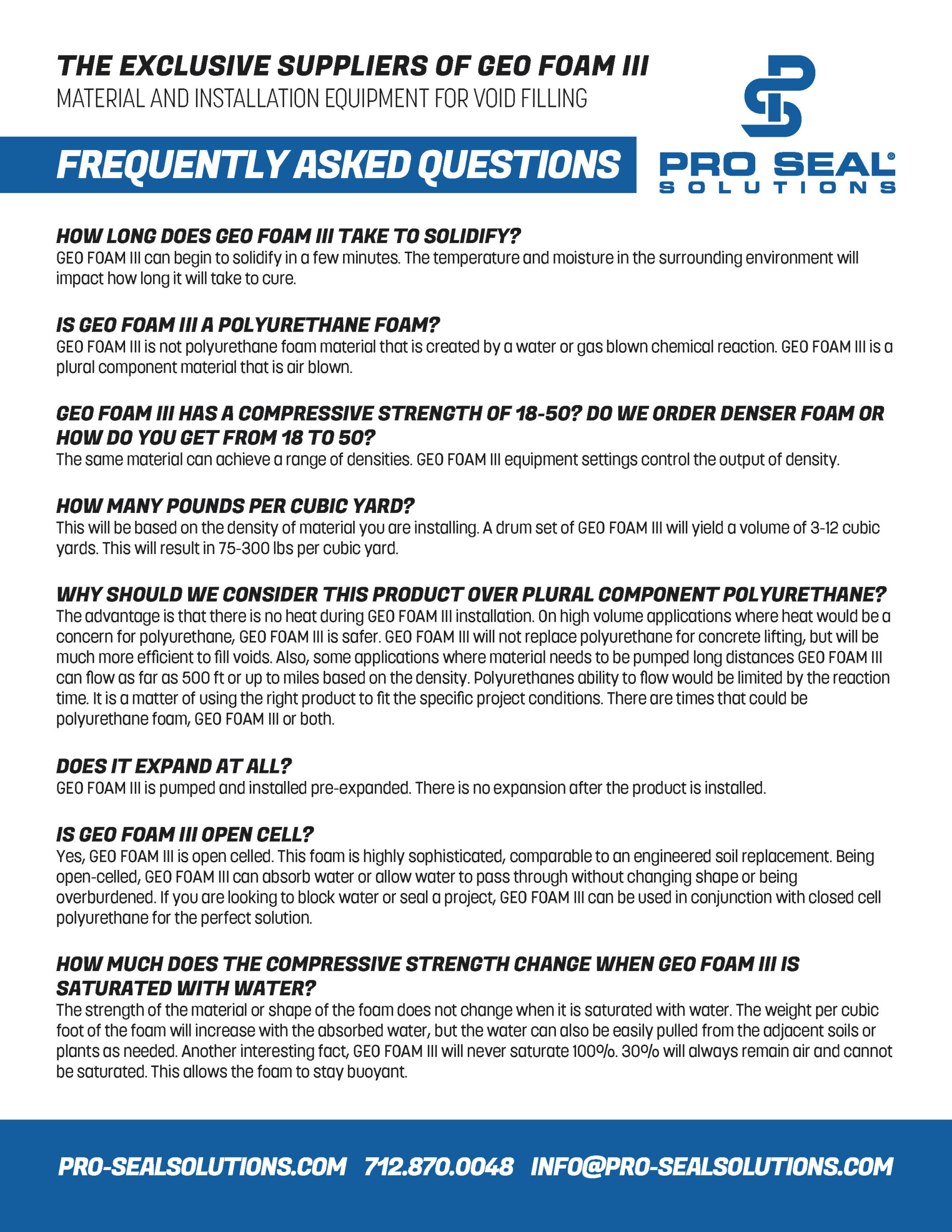What is Geo FoamjectionTM ?
Considered an upgrade to standard concrete raising, Geo FoamjectionTM is the process of installing foam deeper to increase the load bearing capacity of the soils.
Geo FoamJectionTM …
• An upgrade to sub-surface concrete lifting
• Repair unstable soils
• Installing a stronger foundation to support slabs and structures that settled
• Foam follows the path of least resistance and will fill weak areas
• Fills fissures and ground voids
• Fills voids holding water & displaces collected water
• Increase load bearing capacity of subgrade
• Permanent repair, foam never changes shape or absorbs ground water
• Foam soaks into the weak soils and then expands, binding the soil and making it solid • Does not leach chemicals into the ground
Nature Does it Best –
Trees roots hold together loose soil.
As a tree grows, the roots sprawl out in different
directions. It is often suggested to prevent erosion that you plant trees that develop root systems. The root systems grow to intertwine with the dirt and hold it together. Geo FOAMJECTION creates man-made root systems with foam.
For a Geo FoamjectionTM price list, contact ProSeal Solutions! 712.870.0048
Polyurethane Concrete Raising vs. Traditional Mudjacking
Polyurethane concrete raising equipment is costly, and poly foam for concrete leveling is 4 to 5 times more expensive than mudjacking. So, why would polyurethane concrete raising be used instead of traditional mudjacking? To answer this question, four other major questions need to be asked and answered.
Why would anyone spend 4 to 5 times the amount of money to have their concrete raised using polyurethane opposed to traditional mudjacking?
weight scale mud vs poly with text logoIt pays to use the more expensive polyurethane method when raising slabs that are poured over very unstable or unsuitable fill. Polyurethane weighs 2-4 pounds per cubic foot compared to 100-150 pounds per cubic foot of traditional mud, making polyurethane material much less likely to overburden unstable soil. In an article written by G. L. Bowen PE. LLC, Helical Piers & Polyurethane Foaming in the April addition of Helical Pier World, Mr. Bowen discussed the advantages of using closed cell polyurethane to fill voids and support floors over peat moss soils in Alaska. In situations like this, light weight polyurethane has a tremendous advantage over much heavier mudjacking materials.
Is polyurethane strong enough to raise and support concrete slabs?
Traditional mudjacking does have an advantage over polyurethane when it comes to compressive strengths. A contractor can make the compressive strength of mudjacking material be whatev- er is desired by adding cement or combining cement with lime or sand achieving compressive strengths of 2,400 PSI. Polyurethane’s compressive strength is consistently around 80 to 100 PSI. It is preferable to pump a higher compressive strength material than the existing sub-base.
Does the finished job look better than traditional mudjacking?
A feature of polyurethane that will make the end results more attractive, especially to the residential market, is a smaller injection hole. Polyurethane utilizes a hole that is only 5/8” or smaller, compared to mudjacking holes that run between 1” and 2”.
Who wants their concrete raised using polyurethane foam?
US Departments of Transportation seem to be preferring the use of polyurethane concrete lifting for sagging bridge approaches or removing dips in highways. The main reason being the light weight characteristic of the material which will not overburden the soil.
Our experience tells us that conventional mudjacking will be around for a long time. The average consumer will always look for the most inexpensive way to fix settled concrete. However, poly- urethane concrete lifting has found a home and will be the solution to raising slabs when a light weight material is needed.
Polyurethane Concrete Raising
There’s nothing more sad than some sunken concrete…
Polyurethane concrete raising and mudjacking are two methods used to raise and support sunken or unstable concrete slabs, by drilling holes and pumping material under the concrete slab.
» See polyurethane concrete raising in action! How it works
poly-hole-with-dimeOur polyurethane foam method uses the concrete slab itself as a means of delivering poly foams that raise concrete, fill voids, and stabilize soils. A 5⁄8” hole is drilled through the slab into the subgrade. A tapered delivery port is installed into the 5⁄8” hole. The injection gun is connected to the port. The injection gun delivers the polyurethane material through the port and slab. Expansion of the material occurs within seconds, compressing loose soils and raising concrete.
A precise, easy process
Raising concrete with polyurethane foam is done with incremental injections. Lifting foam will fully expand within 10-15 seconds allowing you to monitor the raising and preventing over raising the slab. We suggest using an air-purged gun to deliver foam under the slab. This equipment will keep the injection port open between injections, allowing the foam to fully expand before injecting more foam material.
The process for void filling is the same as concrete raising: drilling, port installation, and injecting the material. All dual component polyurethane foams create heat when installed. Void fills must be done in a layering method to allow heat to dissipate safely. We will issue a Stewardship manual to all dual component polyurethane customers. This manual covers safety precautions that must be observed when injecting dual component polyurethane foams.
Joint/Slab Stabilization: Slab stabilization is often required when slabs lack support, but may or may not be settled. Slabs can crack when loads exceeding its capacity are applied.
Slab/joint stabilization applications require the voids to be filled to eliminate movement and offer support. This type of foam is specifically designed for joint/slab stabilization applications due to its very long reaction time and minimal expansion strength. It will take longer to expand, allowing for better coverage under the slab or down a joint.
Seawall Repair: With every wave, soil washes away and water gets through cracks and gaps in the wall. As cracks and voids form, the wall joints can begin failing. Structural damage may be occurring and a solid foundation will be in jeopardy. You can repair a seawall with HydroFOAM: fill voids, stabilize loose soils and seal leaks at a fraction of the cost of wall replacement. Repair- ing seawalls with HydroFOAM versus grout or cement doesn’t add weight to a soft soil and the repair will last longer. Learn more here>>
A quicker, more cost-effective choice
When compared to concrete replacement, the process of raising concrete with HMI’s polyurethane foam is inexpensive. It is also exponentially faster than replacing concrete. Repaired areas are ready within minutes to be utilized, as they were intended. Polyurethane’s ease of material process and clean-up are some distinct advantages over traditional mudjacking with grout.
Polyurethane Concrete Raising
There’s nothing more sad than some sunken concrete…
Polyurethane concrete raising and mudjacking are two methods used to raise and support sunken or unstable concrete slabs, by drilling holes and pumping material under the concrete slab.
A precise, easy process
Raising concrete with polyurethane foam is done with incremental injections. Lifting foam will fully expand within 10-15 seconds allowing you to monitor the raising and preventing over raising the slab. We suggest using an air-purged gun to deliver foam under the slab. This equipment will keep the injection port open between injections, allowing the foam to fully expand before injecting more foam material.
Polyurethane Foam Can Also Be Used for:
Void Filling: Concrete settling is not the only issue our foams can solve. Voids under slabs are often present in areas where wash out or excessive settling have occurred. This material will weigh on average 15-25 times less than a traditional mudjacking or cementitious grout mix, applying less stress on an already failed subgrade.
Seawall Repair: With every wave, soil washes away and water gets through cracks and gaps in the wall. As cracks and voids form, the wall joints can begin failing. Structural damage may be occurring and a solid foundation will be in jeopardy. You can repair a seawall with HydroFOAM: fill voids, stabilize loose soils and seal leaks at a fraction of the cost of wall replacement. Repair- ing seawalls with HydroFOAM versus grout or cement doesn’t add weight to a soft soil and the repair will last longer. Learn more here>>
A quicker, more cost-effective choice
When compared to concrete replacement, the process of raising concrete with HMI’s polyurethane foam is inexpensive. It is also exponentially faster than replacing concrete. Repaired areas are ready within minutes to be utilized, as they were intended. Polyurethane’s ease of material process and clean-up are some distinct advantages over traditional mudjacking with grout.



